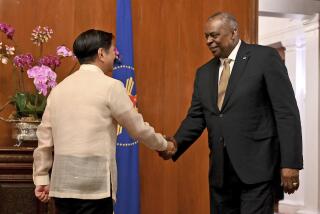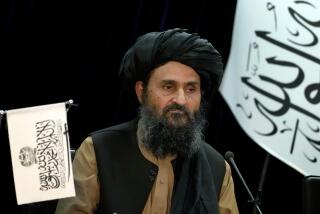Afghanistan truce successful so far, U.S. ready to sign peace deal with Taliban

As they moved closer to signing a landmark agreement aimed at ending the United States’ longest war and withdrawing its troops, U.S., Taliban and Afghan officials scrambled Friday to ensure that pending details didn’t undermine the deal before it ever took effect.
The agreement that seeks to freeze nearly two decades of fighting was scheduled to be signed Saturday at a ceremony in Doha, Qatar, by U.S. negotiators and leaders of the Taliban militancy that long opposed both the Afghan government and American administrations that backed it.
Separately, the U.S. was expected to sign an accord with the Kabul government. All parties will agree to an eventual cease-fire and the opening of negotiations for a political settlement.
“If the Taliban and the government of Afghanistan live up to these commitments, we will have a powerful path forward to end the war in Afghanistan and bring our troops home,” President Trump said in a statement Friday. “When I ran for office, I promised the American people I would begin to bring our troops home, and seek to end this war. We are making substantial progress on that promise.”
Trump announced that Secretary of State Michael R. Pompeo will attend the Doha ceremony, while Defense Secretary Mark Esper will issue a joint statement with the Afghan government.
A crucial test leading to this point was a weeklong pause in violence in Afghanistan agreed to on Feb. 22 by the United States and the Taliban. On Friday, Pompeo, testifying before a congressional committee, confirmed the truce appeared to be holding.
“We have seen just these last six days a significant reduction in violence in Afghanistan,” Pompeo said.
The draft accord, which has not yet been made public, calls for steep reductions in U.S. troop presence during the coming months in return for Taliban promises to deny terrorist groups access to its territory and to renounce an erstwhile ally, Al Qaeda.
But it is the next phase of the negotiations that will determine whether the U.S.-Taliban deal is the first step toward peace in Afghanistan.
Taliban leaders have promised to convene power-sharing talks with Afghan government negotiators, most likely in Oslo, Norway, within days. The U.S., for its part, is planning rapid initial withdrawals, going from 12,000 troops there now to 8,600 by early summer, according to current and former officials familiar with the agreement, the result of more than a year of U.S.-Taliban haggling.
Yet the talks could easily be delayed or break down entirely if violence resumes, the Taliban backs away from the talks or the Afghan government cannot overcome its own internal divisions to negotiate with the Taliban.
Official Afghan presidential election results announced last week — nearly five months after the vote — gave the victory to incumbent President Ashraf Ghani.
But his chief rival, Abdullah Abdullah, has refused to recognize that outcome and declared himself the victor. Within days, the opposing camps deployed their own security forces in an increasingly tense Kabul, and regional warlords were choosing sides.
To avoid a deepening crisis, Ghani agreed to U.S. requests he postpone the inauguration — which had been planned for Thursday — until March 9, just before talks with the Taliban are due to start.
Ghani has so far been excluded from direct participation in the talks with the Taliban, which have been handled by the U.S. negotiator, Zalmay Khalilzad, and his deputy, Molly Phee, both veteran State Department diplomats. The Trump administration recognized Ghani’s victory only in the most tepid terms, and insisted that a wide range of Afghan political and social organizations will be represented in the next phase of negotiations. Who will make up that delegation, however, is far from being settled, as is its size.
Another potential sticking point not yet resolved involves the exchange of prisoners. The Taliban is demanding Kabul release 5,000 of its fighters, while the government wants 1,000 men released by the Taliban. Ghani, as well as some U.S. officials, have expressed concerns that some of the Taliban prisoners are die-hard militants who would be determined to resume the fight.
Despite the upheaval, Afghans are somewhat optimistic about the prospects for peace, said Ali Adili, a researcher with the Afghanistan Analysts Network, which monitors the country closely.
“There has been a positive feeling among Afghans regarding the reduction in violence,” he said. “But many are of course worried about the next steps in the peace process. There is uncertainly; there is both fear and hope.”
Trump, seeking an election-year troop withdrawal, is likely to go ahead with the initial draw-down no matter what happens. But he may be reluctant to continue the reductions below 8,600 troops if Afghanistan appears to be plunging back into chaos or there are U.S. casualties, analysts say.
Too hasty a withdrawal could give Democrats an opening to blame Trump for allowing Afghanistan to again become a haven for groups threatening the U.S. or for squandering advances in Afghan women’s rights and education if the Taliban is permitted to take formal control of some areas of the country.
Trump abruptly backed out of a deal with the Taliban last fall after it launched an attack that killed a U.S. soldier.
“The war will continue for the Afghans. I’m fairly positive about that,” said Paul D. Miller, a Georgetown University professor who oversaw Afghanistan policy at the National Security Council under Presidents George W. Bush and Obama. “My great fear is that it will draw the U.S. back into it.”
U.S. officials argue that all parties involved in the long war are exhausted and have come to the realization that it is a fight that cannot be won militarily. Yet even among Trump’s traditional supporters, there are concerns about whether the U.S. and the Afghan government can trust the Taliban.
A group of 22 Republican lawmakers sent a letter this week to Pompeo and Esper, cautioning them against entering a “dangerous” deal with a “terrorist group” that would put American security interests at risk. They demanded the U.S. refrain from sharing intelligence with the Taliban or agreeing prematurely to a full troop withdrawal.
The so-called reduction in violence this week has gone relatively smoothly, as both sides scaled back their operations to prevent incidents that could derail the agreement.
While attacks and skirmishes have been reported throughout the country — including in Zabol province, where a previous unofficial cease-fire didn’t last — both sides said they were holding fire. Operations targeting Islamic State fighters, who are also present in Afghanistan, continued.
“We have seen violence reduce up to 80%,” Afghan Interior Minister Massoud Andarabi told The Times on Thursday, adding that he hoped “the Taliban will continue the reduction in violence.”
On Wednesday, an explosion in the capital, Kabul, injured nine civilians, but the Taliban was quick to deny any involvement. Another blast on Thursday killed one and injured seven, but once again it wasn’t claimed by the Taliban.
The U.S. set up a “communications channel” in Doha that will be used by both sides to explain violence or determine responsibility as well as to keep each other informed of their movements.
“As far as it concerns us, the reduction in violence was executed exceptionally well over the past week,” said Zabiullah Mujahid, a Taliban spokesman. “We honored our commitment by reducing our operations exponentially, and our assessment of it is rather positive.”
The Afghan army halted its operations against the Taliban for the week. “If the Taliban keeps it up too, our operations will remain defensive and not offensive,” said Fawad Aman, a spokesman for the Afghan Ministry of Defense.
The U.S. military said it carried out two airstrikes Wednesday that killed three members of Islamic State, a terrorist group that is active in eastern Afghanistan, according to Col. Sonny Leggett, a military spokesman.
Also Wednesday, the top U.S. commander, Gen. Austin “Scott” Miller, and Afghan Defense Minister Asadullah Khalid strolled the streets of Kabul without protective vests, speaking to pedestrians, posing for selfies and visiting shops. Both have previously been targeted, with Miller escaping an attack in Kandahar in 2018 that left two senior Afghan officials dead.
Times staff writer Cloud reported from Doha and special correspondent Glinski from Kabul. Times staff writer Tracy Wilkinson in Washington contributed to this report.
More to Read
Start your day right
Sign up for Essential California for news, features and recommendations from the L.A. Times and beyond in your inbox six days a week.
You may occasionally receive promotional content from the Los Angeles Times.







